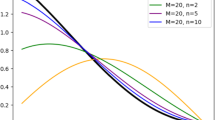Abstract
The problem of a firm willing to optimally promote and sell a single product on the market is here undertaken. The awareness of such product is modeled by means of a Nerlove–Arrow goodwill as a state variable, differentiated jointly by means of time and of age of the segments in which the consumers are clustered. The problem falls into the class of infinite horizon optimal control problems of PDEs with age structure that have been studied in various papers either in cases when explicit solutions can be found or using Maximum Principle techniques. Here, assuming an infinite time horizon, we use some dynamic programming techniques in infinite dimension to characterize both the optimal advertising effort and the optimal goodwill path in the long run. An interesting feature of the optimal advertising effort is an anticipation effect with respect to the segments considered in the target market, due to time evolution of the segmentation. We analyze this effect in two different scenarios: in the first, the decision-maker can choose the advertising flow directed to different age segments at different times, while in the second she/he can only decide the activation level of an advertising medium with a given age-spectrum.












Similar content being viewed by others
Notes
Note that \(\partial J[u,g]/\partial u, \partial J[u,g]/\partial g\) are in fact the Frechét differential in \(L^2\) with respect to the \(u, g\) variables, respectively.
References
Barucci E, Gozzi F (1998) Investment in a vintage capital model. Res Econ. doi:10.1006/reec.1997.0159
Barucci E, Gozzi F (1999) Optimal advertising with a continuum of goods. Ann Oper Res. doi:10.1023/A:1018922128062
Barucci E, Gozzi F (2001) Technology adpotion and accumulation in a vintage capital model. J Econ. doi:10.1007/BF01231214
Bensoussan A, Da Prato G, Delfour M, Mitter S (2007) Representation and control of infinite dimensional systems. Birkäuser, Boston
Dubè JP, Manchanda P (2005) Differences in dynamic brand competition across markets: an empirical analysis. Mark Sci. doi:10.1287/mksc.1040.0087
Engel KJ, Nagel R (2000) One-parameter semigroups for linear evolution equations. Springer, New York
Faggian S (2005) Regular solutions of Hamilton-Jacobi-Bellman equations arising in economics. Appl Math Optim. doi:10.1007/s00245-004-0809-z
Faggian S (2008a) Infinite dimensional Hamilton-Jacobi equations and applications to boundary control problems with state constraints. SIAM J Control Optim. doi:10.1137/070683738
Faggian S (2008b) Applications of dynamic programming to economic problems with vintage capital. Dyn Contin Discret Impuls Syst Ser A Math Anal 15:527–553
Faggian S, Gozzi F (2010) Optimal investment models with vintage capital: dynamic programming approach. J Math Econ. doi:10.1016/j.jmateco.2010.02.006
Feichtinger G, Tragler G, Veliov VM (2003) Optimality conditions for age-structured control systems. J Math Anal Appl. doi:10.1016/j.jmaa.2003.07.001
Feichtinger G, Hartl RF, Kort PM, Veliov VM (2006) Anticipation effects of technological progress on capital accumulation: a vintage capital approach. J Econ Theory. doi:10.1016/j.jet.2004.10.001
Grass D, Caulkins JP, Feichtinger G, Tragler G, Behrens DA (2008) Optimal control of nonlinear processes. Springer, Berlin
Grosset L, Viscolani B (2005) Advertising for the introduction of an age-sensitive product. Optim Control Appl Methods. doi:10.1002/oca.758
Grosset L, Viscolani B (2008) Advertising in a segmented market: comparison of media choices. IMA J Manag Math. doi:10.1093/imaman/dpm040
Jørgensen S, Zaccour G (2004) Differential games in marketing. Kluwer, Boston
Kotler P, Wong V, Saunders J, Armstrong G (2005) Principles of marketing. Pearson Education, Essex
Marinelli C, Savin S (2008) Optimal distributed dynamic advertising. J Optim Theory Appl. doi:10.1007/s10957-007-9350-6
Nerlove M, Arrow JK (1962) Optimal advertising policy under dynamic conditions. Economica 29:129–142
Pazy A (1983) Semigroups of linear operators and applications to partial differential equations. Springer, New York
Acknowledgments
We thanks both Anonymous Referees for their review: we highly appreciate the comments and suggestions, which significantly contributed to improving the quality of the paper.
Author information
Authors and Affiliations
Corresponding author
Electronic supplementary material
Below is the link to the electronic supplementary material.
Rights and permissions
About this article
Cite this article
Faggian, S., Grosset, L. Optimal advertising strategies with age-structured goodwill. Math Meth Oper Res 78, 259–284 (2013). https://doi.org/10.1007/s00186-013-0443-8
Received:
Accepted:
Published:
Issue Date:
DOI: https://doi.org/10.1007/s00186-013-0443-8




